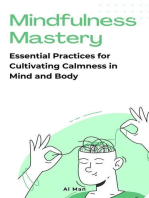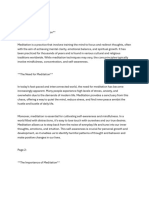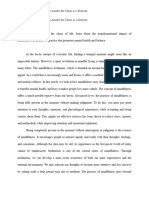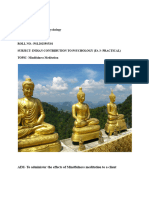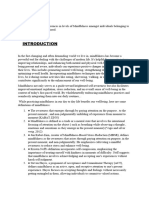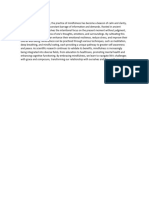New Microsoft Word Document
New Microsoft Word Document
Uploaded by
katsuyoshiyuki3Copyright:
Available Formats
New Microsoft Word Document
New Microsoft Word Document
Uploaded by
katsuyoshiyuki3Original Title
Copyright
Available Formats
Share this document
Did you find this document useful?
Is this content inappropriate?
Copyright:
Available Formats
New Microsoft Word Document
New Microsoft Word Document
Uploaded by
katsuyoshiyuki3Copyright:
Available Formats
Title: The Power of Mindfulness: Cultivating Presence and Well-being
Introduction:
In today's fast-paced and often stressful world, the practice of mindfulness has gained significant
attention for its potential to enhance well-being and bring about a greater sense of peace and balance.
In this article, we will explore the power of mindfulness, its origins, benefits, and practical techniques to
cultivate presence and improve our overall quality of life.
Understanding Mindfulness:
Mindfulness is the practice of intentionally paying attention to the present moment without judgment. It
involves bringing one's awareness to the present experience, including thoughts, feelings, bodily
sensations, and the surrounding environment. Mindfulness encourages a non-reactive and
compassionate attitude towards our inner and outer experiences, allowing us to develop a deeper
understanding and acceptance of ourselves and the world around us.
Origins and Traditions:
While mindfulness has gained popularity in recent years, its roots can be traced back to ancient Eastern
traditions, particularly within Buddhism. Practices such as meditation and mindfulness have been
cultivated for thousands of years as a means to cultivate wisdom, compassion, and spiritual growth. In
modern times, mindfulness has been secularized and integrated into various therapeutic approaches,
wellness programs, and everyday life.
Benefits of Mindfulness:
The practice of mindfulness offers a multitude of benefits for our mental, emotional, and physical well-
being. Research has shown that regular mindfulness practice can reduce stress and anxiety, improve
attention and cognitive functioning, enhance emotional regulation and resilience, and promote overall
psychological well-being. It can also have positive effects on physical health, including reducing blood
pressure, improving sleep quality, and boosting the immune system.
You might also like
- 12.origin of Mindfulness MeditationDocument9 pages12.origin of Mindfulness Meditationrodrigo3champalimaudNo ratings yet
- Mindfulness and Meditation: A Practical Guide to Calmness and Mental Well-beingFrom EverandMindfulness and Meditation: A Practical Guide to Calmness and Mental Well-beingNo ratings yet
- Mindfulness: Navigating Mindfulness in the Modern AgeFrom EverandMindfulness: Navigating Mindfulness in the Modern AgeRating: 5 out of 5 stars5/5 (1)
- Nurturing Presence in A Busy WorldDocument2 pagesNurturing Presence in A Busy WorldjfafkdiutbuvzgewtaNo ratings yet
- History and Origins of Mindfulness Practices: Ancient Wisdom for Modern Stress Relief and HappinessFrom EverandHistory and Origins of Mindfulness Practices: Ancient Wisdom for Modern Stress Relief and HappinessNo ratings yet
- The Art of Mindfulness - Navigating The Present For A Balanced LifeDocument4 pagesThe Art of Mindfulness - Navigating The Present For A Balanced LifeMaalav WhorraNo ratings yet
- Mindful Moments: A Journey to Peace and Presence: Embrace Life's Quiet Power Through Mindfulness for NewcomersFrom EverandMindful Moments: A Journey to Peace and Presence: Embrace Life's Quiet Power Through Mindfulness for NewcomersNo ratings yet
- Be MindfullDocument2 pagesBe MindfulljfafkdiutbuvzgewtaNo ratings yet
- Meditation Mastery: Embrace Mindfulness To Transform Your LifeDocument58 pagesMeditation Mastery: Embrace Mindfulness To Transform Your LifeAditya trimukheNo ratings yet
- First Two Chapters of Book About MindfullnesDocument4 pagesFirst Two Chapters of Book About MindfullneskacperisamNo ratings yet
- Emotional balance through mindfulness: Learn How To Develop Your Ability To Be Mindful And Live With IntentionFrom EverandEmotional balance through mindfulness: Learn How To Develop Your Ability To Be Mindful And Live With IntentionNo ratings yet
- DocumentDocument2 pagesDocumentluvshanuanshuNo ratings yet
- Mindfulness Mastery : A Course to Cultivate Present Moment AwarenessFrom EverandMindfulness Mastery : A Course to Cultivate Present Moment AwarenessNo ratings yet
- Mindful Mastery: Harnishing Mindfulness for Everyday JoyFrom EverandMindful Mastery: Harnishing Mindfulness for Everyday JoyNo ratings yet
- The Mindful Journey: Discovering Peace and Clarity in Everyday LifeFrom EverandThe Mindful Journey: Discovering Peace and Clarity in Everyday LifeNo ratings yet
- Zen and Now The Meditation Time Machine: Journey Through the Ages of Mindfulness, Yoga, and Spiritual Growth from Ancient Practices to Modern Wellness PhenomenonFrom EverandZen and Now The Meditation Time Machine: Journey Through the Ages of Mindfulness, Yoga, and Spiritual Growth from Ancient Practices to Modern Wellness PhenomenonNo ratings yet
- The Meditation Miracle: Transform Your Life with Mindfulness for Stress Relief, Better Sleep, Enhanced Cognitive Performance, Emotional Healing, and Personal GrowthFrom EverandThe Meditation Miracle: Transform Your Life with Mindfulness for Stress Relief, Better Sleep, Enhanced Cognitive Performance, Emotional Healing, and Personal GrowthNo ratings yet
- Mindfulness Across Millennia: Ancient Practices in Modern PsychologyFrom EverandMindfulness Across Millennia: Ancient Practices in Modern PsychologyNo ratings yet
- The Meditation Handbook: A Practical Guide to Finding Inner PeaceFrom EverandThe Meditation Handbook: A Practical Guide to Finding Inner PeaceNo ratings yet
- How To Meditate For Beginners: Practical Ways to Relieve Everyday Stress and Anxiety From the MindFrom EverandHow To Meditate For Beginners: Practical Ways to Relieve Everyday Stress and Anxiety From the MindNo ratings yet
- The Art of Mindful Living: Cultivating Inner Peace and HappinessFrom EverandThe Art of Mindful Living: Cultivating Inner Peace and HappinessNo ratings yet
- The Mindful Path: Finding Clarity and Serenity through MeditationFrom EverandThe Mindful Path: Finding Clarity and Serenity through MeditationNo ratings yet
- Journey to the Divine: Exploring Spirituality for Religious and Spiritual SeekersFrom EverandJourney to the Divine: Exploring Spirituality for Religious and Spiritual SeekersNo ratings yet
- The Art of Meditation-A Journey WithinDocument2 pagesThe Art of Meditation-A Journey WithinMuhammad IrfanNo ratings yet
- Mindfulness Revolution: Discover the Power of Living in the Present Moment and Unlocking Your True PotentialFrom EverandMindfulness Revolution: Discover the Power of Living in the Present Moment and Unlocking Your True PotentialNo ratings yet
- The Power of Meditation: Unlocking Inner Peace and Mental ClarityDocument1 pageThe Power of Meditation: Unlocking Inner Peace and Mental ClarityCosmin PopescuNo ratings yet
- Discovering Mindful Living Amidst The Chaos As A KenyanDocument3 pagesDiscovering Mindful Living Amidst The Chaos As A Kenyancapela elvisNo ratings yet
- Preetika - Fa 3 (Indian Psychology)Document16 pagesPreetika - Fa 3 (Indian Psychology)Preetika AgarwalNo ratings yet
- Positive PrintDocument22 pagesPositive PrintChhavi MudgalNo ratings yet
- The Art of MindfulnessDocument1 pageThe Art of Mindfulnessnicolson1602No ratings yet
- Mindfulness MasteryDocument15 pagesMindfulness Masteryswathibaskar952No ratings yet
- MoindfulDocument2 pagesMoindfulsiddharthgurung.weempowernepalNo ratings yet
- Text 1Document1 pageText 1Fogo galaticoNo ratings yet
- The Inner Path - History and Philosophy of Mindfulness: Subtitle: Learn about meditation techniques, deal with stress and anxiety, improve your mental and physical health, and live a life of peace.From EverandThe Inner Path - History and Philosophy of Mindfulness: Subtitle: Learn about meditation techniques, deal with stress and anxiety, improve your mental and physical health, and live a life of peace.No ratings yet
- New Text DocumentDocument2 pagesNew Text Documentxijoja8358No ratings yet
- Meditation for Beginners: Discovering Inner Peace and Clarity: A Step-by-Step Guide to Meditation for BeginnersFrom EverandMeditation for Beginners: Discovering Inner Peace and Clarity: A Step-by-Step Guide to Meditation for BeginnersNo ratings yet
- Mindfulness for beginners - The First Step Towards Mindfulness: Discover the benefits of meditation and transform your life in 31 chaptersFrom EverandMindfulness for beginners - The First Step Towards Mindfulness: Discover the benefits of meditation and transform your life in 31 chaptersNo ratings yet
- MindfulnessDocument4 pagesMindfulnessscarynumbers999No ratings yet
- The Benefits of MindfulnessDocument2 pagesThe Benefits of MindfulnessceliadessardNo ratings yet



